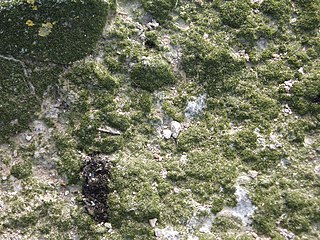
The glaucophytes, also known as glaucocystophytes or glaucocystids, are a small group of unicellular algae found in freshwater and moist terrestrial environments, less common today than they were during the Proterozoic. The stated number of species in the group varies from about 14 to 26. Together with the red algae (Rhodophyta) and the green algae plus land plants, they form the Archaeplastida.

The chlorarachniophytes are a small group of exclusively marine algae widely distributed in tropical and temperate waters. They are typically mixotrophic, ingesting bacteria and smaller protists as well as conducting photosynthesis. Normally they have the form of small amoebae, with branching cytoplasmic extensions that capture prey and connect the cells together, forming a net. These extensions are dependent on the presence of light and polymerization of the actin cytoskeleton. They may also form flagellate zoospores, which characteristically have a single subapical flagellum that spirals backwards around the cell body, and walled coccoid cells.

Charales is an order of freshwater green algae in the division Charophyta, class Charophyceae, commonly known as stoneworts. Depending on the treatment of the genus Nitellopsis, living (extant) species are placed into either one family (Characeae) or two. Further families are used for fossil members of the order. Linnaeus established the genus Chara in 1753.

AlgaeBase is a global species database of information on all groups of algae, both marine and freshwater, as well as sea-grass.

Eustigmatophytes are a small group of eukaryotic forms of algae that includes marine, freshwater and soil-living species.

Bryopsidales is an order of green algae, in the class Ulvophyceae.

Prasiolales is an order of green algae in the class Trebouxiophyceae. Members of this order are ecologically widespread and are found in freshwater, marine, and terrestrial habitats from the Arctic to the Antarctic.

Codiaceae is a family of green algae in the order Bryopsidales.
Bryopsidella is a genus of green algae in the family Bryopsidaceae.
Pseudopenicillus is a genus of green algae in the family Udoteaceae.
Rhexinema is a genus of green algae in the order Ulotrichales. Recent research has suggested that the genus Helicodictyon is a synonym of Rhexinema.

Sykidion is a genus of green algae. Pseudoneochloris is a synonym of this genus. As of March 2022, Sykidion was the only genus in the family Sykidiacaeae, which was the only family in the order Sykidiales.
Trochisciopsis is a genus of green algae, in the family Trebouxiaceae.

Chlorochytrium is a genus of green algae, in the family Chlorochytriaceae.

Palmodictyon is a genus of green algae in the family Radiococcaceae.

Chlorokybus is a multicellular (sarcinoid) genus of basal green algae or charophyte. It has been classified as the sole member of the family Chlorokybaceae, which is the sole member of the order Chlorokybales, in turn the sole member of the class Chlorokybophyceae. It grows on soil and rock surfaces, and is rare.
Mesostigma is a genus of unicellular biflagellate freshwater green algae, with a single species Mesostigma viride, covered by an outer layer of basket‐like scales instead of a cell wall. It is the only known genus in the class Mesostigmatophyceae.

Acicularia is an extinct genus of green algae in the family Dasycladaceae.
Filoprotococcus is a genus of green algae in the order Ulotrichales. It was once regarded as a synonym of Trichosarcina. However, it is now accepted as a genus in its own right, and Trichosarcina is considered taxonomically uncertain.











